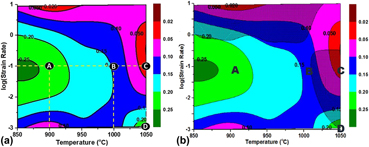Crossref Citations
This article has been cited by the following publications. This list is generated based on data provided by
Crossref.
Bibhanshu, Nitish
Bhattacharjee, Amit
and
Suwas, Satyam
2019.
Influence of Temperature and Strain Rate on Microstructural Evolution During Hot Compression of Ti-45Al-xNb-0.2C-0.2B Titanium Aluminide Alloys.
JOM,
Vol. 71,
Issue. 10,
p.
3552.
Dong, Fuyu
Yuan, Ye
Li, Weidong
Zhang, Yue
Liaw, Peter K.
Yuan, Xiaoguang
and
Huang, Hongjun
2020.
Hot deformation behavior and processing maps of an equiatomic MoNbHfZrTi refractory high entropy alloy.
Intermetallics,
Vol. 126,
Issue. ,
p.
106921.
Yi, Hai-long
Wei, Daixiu
Wang, Yingchen
Wang, Liqiang
Fang, Ming-yang
Yang, Kang
and
Kato, Hidemi
2020.
Hot Deformation and Dynamic Recrystallization Behavior of CoCrNi and (CoCrNi)94Ti3Al3 Medium Entropy Alloys.
Metals,
Vol. 10,
Issue. 10,
p.
1341.
Bibhanshu, Nitish
and
Suwas, Satyam
2020.
Mechanism of shear band formation and dynamic softening in a two-phase (α2 + γ) titanium aluminide.
Journal of Materials Research,
Vol. 35,
Issue. 13,
p.
1635.
Sathiaraj, G. Dan
Pukenas, Aurimas
and
Skrotzki, Werner
2020.
Texture formation in face-centered cubic high-entropy alloys.
Journal of Alloys and Compounds,
Vol. 826,
Issue. ,
p.
154183.
Haghdadi, N.
Primig, S.
Annasamy, M.
Cizek, P.
Hodgson, P.D.
and
Fabijanic, D.M.
2020.
On the hot-worked microstructure of a face-centered cubic Al0.3CoCrFeNi high entropy alloy.
Scripta Materialia,
Vol. 178,
Issue. ,
p.
144.
Bibhanshu, Nitish
Bhattacharjee, Amit
and
Suwas, Satyam
2020.
Hot deformation response of titanium aluminides Ti–45Al-(5, 10)Nb-0.2B-0.2C with pre-conditioned microstructures.
Journal of Alloys and Compounds,
Vol. 832,
Issue. ,
p.
154584.
Li, Feng
and
Li, Zhenhua
2020.
High wear resistance hypoeutectic Fe–C–B alloy by hot rolling.
Materials Research Express,
Vol. 7,
Issue. 1,
p.
016551.
Patnamsetty, Madan
Somani, Mahesh C.
Ghosh, Sumit
Ahmed, Shahroz
and
Peura, Pasi
2020.
Processing map for controlling microstructure and unraveling various deformation mechanisms during hot working of CoCrFeMnNi high entropy alloy.
Materials Science and Engineering: A,
Vol. 793,
Issue. ,
p.
139840.
Wang, Qiang
Gao, Tengfei
Du, Hui
Hu, Qiang
Chen, Qiang
Fan, Zitian
Zeng, Liangcai
and
Liu, Xinwang
2021.
Hot compression behaviors and microstructure evolutions of a cast dual-phase NiCoFeCrAl0.7 high-entropy alloy.
Intermetallics,
Vol. 138,
Issue. ,
p.
107314.
Bibhanshu, Nitish
Prasad, Natasha
Nayan, Niraj
Avadhani, G.S.
Ray, R.K.
and
Suwas, Satyam
2022.
Mechanical response of as-cast equiatomic high entropy alloy CuFeCoNiMn.
Intermetallics,
Vol. 143,
Issue. ,
p.
107461.
Aydinyan, S.
Kirakosyan, H.
Sargsyan, A.
Volobujeva, O.
and
Kharatyan, S.
2022.
Solution combustion synthesis of MnFeCoNiCu and (MnFeCoNiCu)3O4 high entropy materials and sintering thereof.
Ceramics International,
Vol. 48,
Issue. 14,
p.
20294.
Savaedi, Zeinab
Motallebi, Reza
and
Mirzadeh, Hamed
2022.
A review of hot deformation behavior and constitutive models to predict flow stress of high-entropy alloys.
Journal of Alloys and Compounds,
Vol. 903,
Issue. ,
p.
163964.
Lin, Kaifan
Chen, Shih-Che
Lin, Hsin-Chih
and
Yen, Hung-Wei
2022.
Enhancement in mechanical properties through an FCC-to-HCP phase transformation in an Fe-17.5Mn-10Co-12.5Cr-5Ni-5Si (in at%) medium-entropy alloy.
Journal of Alloys and Compounds,
Vol. 898,
Issue. ,
p.
162765.
Sajadi, Seyyed Ali
Toroghinejad, Mohammad Reza
Rezaeian, Ahmad
and
Ebrahimi, Gholam Reza
2022.
A study of hot compression behavior of an as-cast FeCrCuNi2Mn2 high-entropy alloy.
Journal of Alloys and Compounds,
Vol. 896,
Issue. ,
p.
162732.
Nie, Xiaowu
Sheng, Mingqiang
and
Mabi, Awei
2022.
Effect of SPS Sintering Process on Compressive Strength and Magnetic Properties of CoCuFeMnNi Bulk Alloy.
JOM,
Vol. 74,
Issue. 7,
p.
2665.
Sajadi, Seyyed Ali
Toroghinejad, Mohammad Reza
Rezaeian, Ahmad
and
Ebrahimi, Gholam Reza
2022.
Dynamic recrystallization behavior of the equiatomic FeCoCrNi high-entropy alloy during high temperature deformation.
Journal of Materials Research and Technology,
Vol. 20,
Issue. ,
p.
1093.
Chang, Yi-Chun
Lin, Kaifan
Ma, Ju-Lung
Huang, Han-Fu
Chang, Shih-Hsien
and
Lin, Hsin-Chih
2023.
Improvement of Corrosion and Wear Resistance of CoCrNiSi0.3 Medium-Entropy Alloy by Sputtering CrN Film.
Materials,
Vol. 16,
Issue. 4,
p.
1482.
Buzolin, Ricardo Henrique
Masswohl, Markus
Branco Ferraz, Franz Miller
Chrzan, Konrad
Dudziak, Tomasz
and
Poletti, Maria Cecilia
2023.
Microstructure refinement of a cast high entropy alloy by thermomechanical treatments.
Materials Science and Engineering: A,
Vol. 872,
Issue. ,
p.
144931.
Kumar, Piyush
Jain, Reliance
Rahul, M. R.
Ghosh, Abhijit
Samal, Sumanta
and
Phanikumar, Gandham
2023.
High Temperature Deformation Behavior and Processing Maps of FeCoNiCrAlTi Dual Phase High Entropy Alloy.
Metals and Materials International,
Vol. 29,
Issue. 9,
p.
2500.
